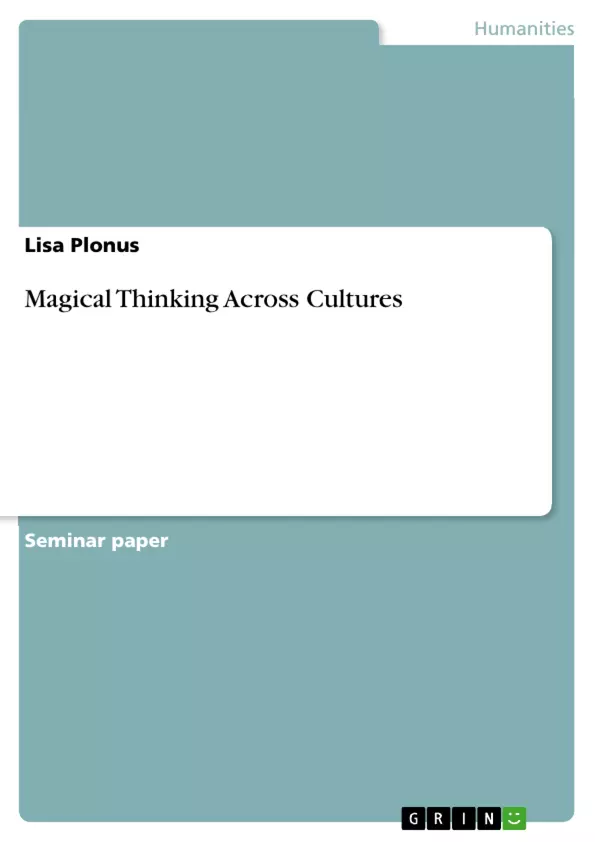In the past decades, much research has been conducted on the topic of magical thinking. Nevertheless, it is a rather poorly discovered topic. The construct is applied in various research areas and can help to describe the behavior of people. To better understand magical thinking within the framework of cross-cultural psychology, the concept is defined, and the relation to culture and reasons for magical thinking are explained in the following work. By means of a qualitative study with German students, the concept is examined in more detail with the aim to highlight commonalities as well as differences to existing literature. Finally, the results are interpreted and related to culture, cognition, and consumer behavior.
Magical thinking can be described as the belief that certain actions can influence objects or events when there is no empirical causal connection between them. This definition already highlights the core of the concept: Magical thinking is detached from science and is also referred to as failure of rationality by researcher. What many definitions of
magical thinking have in common is the connection of the concept to something supernatural. Furthermore, the belief and awareness of the interconnectedness of all things in the world is also assumed to be a possible cause of magical thinking. Nemeroff and Rozin, who have studied the topic of magical thinking very intensively, have developed a working definition of magical thinking, which is the basis of this work.
Their definition consists of five dimensions: The first dimension describes that magical thinking is an intuitive and universal aspect of human thinking. Second, these thought patterns are outlined as making no sense and being detached from scientific theories. The third dimension indicates that magical thinking is a subjective process carried out by individuals. As a fourth aspect, the researchers mention the multidimensionality of magical thinking and that it influences cognitive, emotional, and social functions of individuals. Fifth, the authors state that magical thinking in its most typical way adopts the principles of sympathetic magical thinking. This kind of magical thinking will be discussed in more detail in the further course of this work.
Inhaltsverzeichnis (Table of Contents)
- Introduction
- Literature overview
- Definition
- Different perspectives
- Sympathetic magic
- Culture and other influencing factors
- Reasons for magical thinking
- Methods
- Study design
- Interview structure
- Sample
- Results
- Summary of interviews
- Data analysis
- Participant one
- Participant two
- Discussion
Zielsetzung und Themenschwerpunkte (Objectives and Key Themes)
This work aims to provide a comprehensive overview of magical thinking within the framework of cross-cultural psychology. It defines the concept of magical thinking, explains its relation to culture and the reasons behind it, and examines its prevalence among German students through a qualitative study. The study seeks to highlight commonalities and differences with existing literature, and ultimately, relate the findings to culture, cognition, and consumer behavior.
- Definition and conceptualization of magical thinking
- The role of culture and influencing factors in magical thinking
- Different perspectives on magical thinking, including abnormal psychology and developmental psychology
- Exploring the concept of sympathetic magic, including the law of similarity and the law of contagion
- Examining the prevalence and expression of magical thinking among German students
Zusammenfassung der Kapitel (Chapter Summaries)
- Introduction: This chapter introduces the topic of magical thinking, highlighting its significance in cross-cultural psychology. It outlines the research objectives and the methodology employed in the study.
- Literature overview: This chapter provides a comprehensive overview of the concept of magical thinking, defining it and exploring different perspectives on its origins, development, and implications. It also delves into the concept of sympathetic magic and its underlying principles.
- Methods: This chapter outlines the methodology used in the study, including the study design, interview structure, and sample selection.
- Results: This chapter presents the findings of the study, providing a summary of the interviews and data analysis. It includes insights from two individual participants.
Schlüsselwörter (Keywords)
Magical thinking, cross-cultural psychology, culture, cognition, consumer behavior, sympathetic magic, law of similarity, law of contagion, qualitative research, interview analysis, German students.
- Quote paper
- Lisa Plonus (Author), 2022, Magical Thinking Across Cultures, Munich, GRIN Verlag, https://www.grin.com/document/1205094



